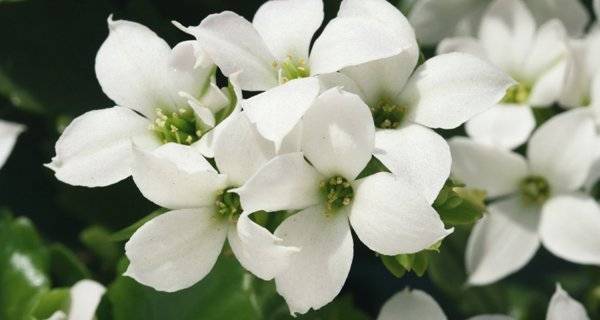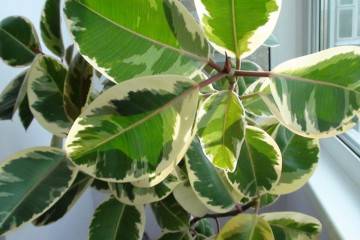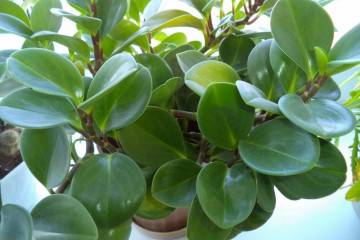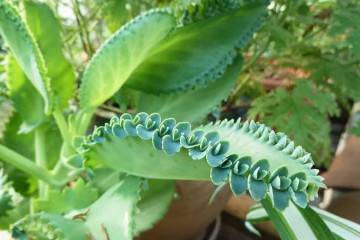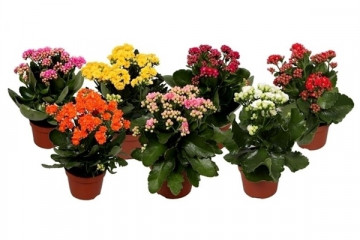Kalanchoe Blossfeld - features of flower care
Content:
There are a number of indoor plants that are quite unpretentious. Unfortunately, many of them are not blooming. It is very difficult to find a lush indoor flower that does not require special care. That is why the Blossfeld Kalanchoe is so popular with flower growers. It requires minimal maintenance and at the same time pleases with colorful and lush blooms.
Kalanchoe Blossfeld
On the shelves of many flower shops, you can see compact potted bushes, which are crowned with a cap of bright flowers. Kalanchoe bloosfeldiana mix is often indicated as the name. It is worth noting that this happens because it is not always possible to accurately determine the variety among the huge variety. The appearance of Kalanchoe Blossfeld does not leave indifferent any fan of indoor flowers.
Description
Kalanchoe Blossfeld belongs to the Tolstyankov family, genus - Kalanchoe (kalanchoe). As a rule, the average plant height does not exceed 25-30 cm.
The leaves of the flower are dense, rounded, dark green in color. They are collected in a rosette from the center of which a stem with inflorescences emerges.
Flowers differ in the number of petals and color depending on the variety. Collected in an outlet, with abundant flowering, completely cover the leaves.
Origin
The homeland of the flower is the island of Madagascar, it was on this territory that the explorer Blossfeld discovered it, who gave him his name - blossfeldiana.
A wild flower that grew naturally was not quite suitable for indoor cultivation. Thanks to the work of breeders, this has become possible and now many species of this plant are available for cultivation.
Application of leaves
Kalanchoe leaves have healing properties. Thanks to this, the plant is used for medical and cosmetic purposes.
For medicinal purposes, Kalanchoe is used in a number of cases:
- runny nose;
- sinusitis;
- cuts, wounds, abrasions.
Due to its bactericidal properties, this plant effectively fights infections and has a disinfecting effect. For the treatment of diseases of the nasal cavity, an infusion of leaves or pure juice is used.
The bactericidal properties of Kalanchoe are used in cosmetology. The sap of the plant effectively relieves inflammation on the skin and has a tonic effect.
Popular varieties
The variety of shades and forms of Kalanchoe flowers is due to the many varieties of this plant.
Lilliputian
Very compact shape. The leaves are rather large, dark green. The flowers are bright scarlet, small, collected in inflorescences.
Tom Tumb
A distinctive feature of the variety is red flowers. Abundant flowering, inflorescences form from a large number of small flowers.
Orange Triumph
This variety has an original shade of flowers - orange. Sometimes a red tint may be present in the color of the petals. One inflorescence can have several shades of flowers at once.
Mia Pluto
It blooms profusely with snowy white flowers. The inner part of the flowers at the base has a greenish-yellow tint.
Breeders from different countries have created a huge variety of Kalanchoe varieties. There are varieties with double flowers that have pale pink, light purple and white-green shades.
Kalanchoe Blossfeld: home care
Kalanchoe Blossfeld does not require special care. It is quite simple to provide him with conditions suitable for growth, the main thing is to take into account the peculiarities of caring for the plant in different periods of the growing season.
Humidity
Unlike many indoor flowers, which are tropical in nature, Kalanchoe does not tolerate high humidity. There is no need to spray it, it is enough to regularly wipe the leaves from dust.
Watering
Watering depends on the phase of the vegetative development of the flower. A feature of the Kalanchoe is the dormant period, which it needs after flowering.
During the period of growth and flowering, watering should be carried out on average once a week. It is better to try each time with your finger how dry it is before moistening the soil.
During the dormant period, the flower is watered very sparingly. If it is possible to keep it at a temperature of 15-17 degrees, water it once a month. In the case when a flower in a pot remains at room temperature above 17 degrees, watering is necessary every 15-20 days.
After watering, remove excess water from the pan and wipe the bottom of the pot. Moisture stagnation should not be allowed.
Top dressing
For full growth and abundant flowering, the Kalanchoe needs feeding. They should be carried out only during the period of active growth and flowering.
As a top dressing, it is best to use a special fertilizer for succulents, which can be purchased at a flower shop. Its composition is designed taking into account the needs of these particular indoor flowers.
Soil quality
The most suitable soil for growing Kalanchoe Brosselfeld is a light and breathable substrate for succulents. It is better to purchase a ready-made mixture in the store.
The demand for the presence of nutrients in the soil is not high for this flower. He can get all the trace elements necessary for growth from fertilizers.
Tank size
For the full growth of Kalanchoe, a pot is needed, slightly larger than the size of the root system. The tightness of the container is an incentive for flowering. A pot that is too spacious can lead to the growth of vegetative mass without flowering.
An important point to pay attention to when buying a pot is the presence of sufficient drainage holes. There should be at least three of them, depending on the size of the container.
Transplant features
For the first few years, Kalanchoe is transplanted annually in May - June. Older plants only need replanting when the pot becomes too tight for them.
The transplant is carried out sequentially:
- Remove the plant from the old pot by laying it on its side.
- A drainage layer of broken brick, expanded clay or fine gravel is poured onto the bottom of the new pot.
- The container is filled with a portion of the prepared soil.
- Place the plant in a pot, shaking off the soil from the roots a little.
- The voids are covered with soil and watered.
- After the earth has settled, the soil is poured to the edge of the pot.
Flowering and dormant period
A feature of the development of Kalanchoe is the presence of a period of activity and rest in this plant.The dormant period begins after the wilting of the inflorescences, at this time the temperature should be lowered and the watering of the plant should be reduced.
The peak of activity can be called the flowering period. At this time, the leaves are practically invisible under the cap of lush inflorescences. Depending on the variety, they can have a wide range of shades. Many breeding varieties have double flowers with many petals. It is during growth and flowering that the flower must be properly looked after.
Reproduction
Breeding Kalanchoe Blossfeld is quite simple. The most effective way to get a new young plant is propagation by leaf and stem cuttings.
Cuttings
Most often, cuttings are used, which remain after pruning, which is carried out to form the plant. Many young seedlings can be obtained from such material.
The lower leaves are removed from the cuttings, leaving only a few of the upper ones. After that, they are placed for rooting in water, peat or sand. Roots appear fairly quickly in the cuttings.
The propagation process by leaf cuttings is identical to that used for stems. It is just as easy and quick to get new young plants from the leaves.
Seeds
It is almost impossible to grow Kalanchoe Blossfeld from seeds at home. This is due to the fact that it is extremely difficult to create suitable conditions for this in an apartment.
The seed propagation method is used only if there is a need to grow a specimen of a rare and unique variety.
Possible growing problems
All the difficulties that can arise when growing Kalanchoe at home are associated with mistakes in care or improper living conditions. There are several reasons why a plant can get sick:
- excessive watering;
- moisture ingress on the leaves;
- feeding inappropriate fertilizer;
- incorrect soil composition;
- lack of lighting;
- non-observance of the temperature regime.
Such mistakes can lead to diseases such as gray and stem rot, late blight and powdery mildew.
Kalanchoe rarely suffers from pest attacks. Sometimes it is affected by aphids, scale insects and spider mites. If parasites are found on the plant, it is necessary to immediately carry out treatment with special preparations. For a while, the flower should be isolated from the rest of the plants.
Kalanchoe Blossfeld is a spectacular indoor flower. It is not picky about care and, at the same time, pleases with regular lush flowering. Among the variety of species of this plant, there are specimens with absolutely stunning color and shape of flowers. Each florist can choose a variety to his taste and decorate his house or apartment with it.




